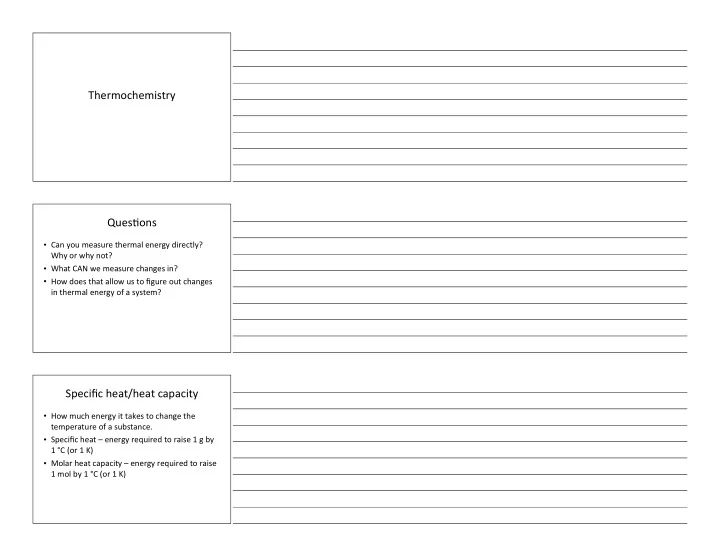

Thermochemistry Ques.ons • Can ¡you ¡measure ¡thermal ¡energy ¡directly? ¡ Why ¡or ¡why ¡not? ¡ • What ¡CAN ¡we ¡measure ¡changes ¡in? • How ¡does ¡that ¡allow ¡us ¡to ¡figure ¡out ¡changes ¡ in ¡thermal ¡energy ¡of ¡a ¡system? Specific ¡heat/heat ¡capacity • How ¡much ¡energy ¡it ¡takes ¡to ¡change ¡the ¡ temperature ¡of ¡a ¡substance. • Specific ¡heat ¡– ¡energy ¡required ¡to ¡raise ¡1 ¡g ¡by ¡ 1 ¡°C ¡(or ¡1 ¡K) • Molar ¡heat ¡capacity ¡– ¡energy ¡required ¡to ¡raise ¡ 1 ¡mol ¡by ¡1 ¡°C ¡(or ¡1 ¡K) ¡
Name Formula Molar ¡mass Molar ¡heat ¡ Specific ¡heat ¡ (g/mol) capacity ¡(J/ ¡mol ¡ (J/g ¡°C) water H 2 O 18 75.4 4.18 methanol CH 3 OH 32 81 2.53 ethanol CH 3 CH 2 OH 48 112 2.44 propanol CH 3 CH 2 CH 2 OH 60 144 2.39 The ¡molar ¡heat ¡capacity ¡increases ¡with ¡molecular ¡weight. ¡Why? – ¡more ¡ways ¡to ¡use ¡energy ¡as ¡the ¡number ¡of ¡atoms ¡and ¡bonds ¡increases ¡(in ¡ vibra.ons ¡and ¡rota.ons). Why ¡is ¡the ¡sp ¡heat ¡of ¡water ¡so ¡high? Lots ¡of ¡molecules ¡per ¡gram ¡(low ¡molecular ¡weight ¡of ¡H2O) Lots ¡of ¡intermolecular ¡aYrac.ons ¡ Add ¡same ¡amount ¡of ¡heat ¡to ¡10g ¡of ¡each ¡-‑ ¡ which ¡will ¡reach ¡the ¡highest ¡temp? Substance Specific ¡Heat ¡(J/g ¡ °C) A. H2O(s) Aluminum 0.90 B. H2O(l) C. Aluminum Copper 0.39 D. Silver Ice ¡H 2 O(s) 2.05 E. One ¡of ¡the ¡other ¡materials ¡in ¡the ¡table Iron 0.45 Silver 0.24 Steam ¡H 2 O(g) 2.01 Water ¡H 2 O ¡(l) 4.19 Which ¡will ¡end ¡up ¡at ¡the ¡lowest ¡temp? Why ¡does ¡water ¡in ¡its ¡difference ¡phases ¡ That ¡is: ¡why ¡does ¡it ¡take ¡different ¡amounts ¡of ¡thermal ¡ energy ¡to ¡raise ¡the ¡temperature ¡of ¡a ¡fixed ¡amount ¡of ¡solid, ¡ liquid ¡or ¡gaseous ¡water? Why ¡does ¡it ¡take ¡so ¡much ¡energy ¡to ¡ raise ¡the ¡temperature ¡of ¡liquid ¡water?
Water ¡and ¡its ¡anomalous ¡proper.es • High ¡specific ¡heat • High ¡mel.ng/boiling ¡point • Low ¡density ¡of ¡ice • Low ¡vapor ¡pressure ¡(the ¡pressure ¡exerted ¡by ¡a ¡ gas ¡above ¡the ¡liquid ¡at ¡a ¡given ¡temperature) Liquid ¡water Solid ¡water
All ¡these ¡proper.es ¡are ¡caused ¡by ¡the ¡ unique ¡structure ¡of ¡water ¡– ¡with ¡leads ¡ to ¡very ¡high ¡intermolecular ¡interac.ons ¡ (which ¡require ¡a ¡lot ¡of ¡energy ¡to ¡ overcome) ¡ Ques.on • What ¡would ¡be ¡the ¡consequences ¡(to ¡life, ¡the ¡ universe ¡and ¡everything) ¡if ¡water ¡were ¡a ¡linear ¡ molecule? Phase ¡Changes • What ¡happens ¡when ¡we ¡remove ¡thermal ¡ energy ¡from ¡a ¡gas? • How ¡do ¡we ¡remove ¡thermal ¡energy ¡from ¡a ¡ gas? • What ¡has ¡to ¡happen ¡for ¡molecules ¡to ¡s.ck ¡ together? • hYp://phet.colorado.edu/simula.ons/ sims.php?sim=States_of_MaYer
Phase ¡Changes ¡and ¡Temperature • Moving ¡from ¡solid ¡ à ¡liquid ¡ à ¡gas ¡or ¡ ¡ ¡ ¡ ¡ ¡ ¡ ¡ ¡ ¡ ¡ ¡Gas ¡ à ¡liquid ¡ à ¡solid • What ¡happens ¡to ¡the ¡temperature ¡at ¡a ¡phase ¡ change? • What ¡is ¡the ¡energy ¡being ¡used ¡for? Phase ¡changes ¡and ¡temperature ¡ 2 . ¡What ¡happens ¡on ¡the ¡molecular ¡level ¡when ¡thermal ¡energy ¡(heat) ¡is ¡added ¡ to ¡boiling ¡water? A ¡ It ¡increases ¡the ¡speed ¡at ¡which ¡molecules ¡collide. ¡The ¡bonds ¡within ¡the ¡ molecules ¡break ¡and ¡cause ¡a ¡release ¡of ¡hydrogen ¡and ¡oxygen ¡gases ¡into ¡the ¡air. B. The ¡water ¡molecules ¡will ¡move ¡faster ¡and ¡the ¡aYrac.ons ¡between ¡them ¡will ¡ be ¡overcome. ¡The ¡temperature ¡of ¡water ¡will ¡not ¡change. ¡ C. It ¡makes ¡the ¡water ¡molecules ¡move ¡faster ¡and ¡bump ¡into ¡each ¡other; ¡ consequently ¡the ¡water ¡temperature ¡will ¡increase ¡in ¡the ¡process. D. It ¡increases ¡the ¡movement ¡of ¡water ¡molecules ¡and ¡overcomes ¡the ¡ aYrac.ons ¡between ¡them. ¡Energy ¡will ¡be ¡released ¡into ¡the ¡environment ¡and ¡ new ¡bonds ¡will ¡form ¡to ¡make ¡water ¡vapor.
Ques.ons • Draw ¡a ¡graph ¡of ¡the ¡change ¡in ¡temperature ¡when ¡equal ¡ amounts ¡of ¡thermal ¡energy ¡are ¡added ¡at ¡the ¡same ¡rate ¡to ¡ equal ¡masses ¡of ¡water, ¡ethanol ¡and ¡propanol. ¡ • Does ¡each ¡sample ¡reach ¡the ¡same ¡temperature? ¡Why ¡or ¡why ¡ not? • Plot ¡the ¡temperature ¡change ¡vs ¡.me ¡as ¡a ¡sample ¡of ¡water ¡ vapor ¡moves ¡from ¡a ¡temperature ¡of ¡110ºC ¡to ¡90 ¡ºC • Draw ¡a ¡molecular ¡level ¡picture ¡of ¡what ¡the ¡sample ¡looks ¡like ¡ at ¡110ºC ¡and ¡90ºC • Explain ¡what ¡is ¡happening ¡at ¡each ¡different ¡part ¡of ¡your ¡ graph.
Recommend
More recommend